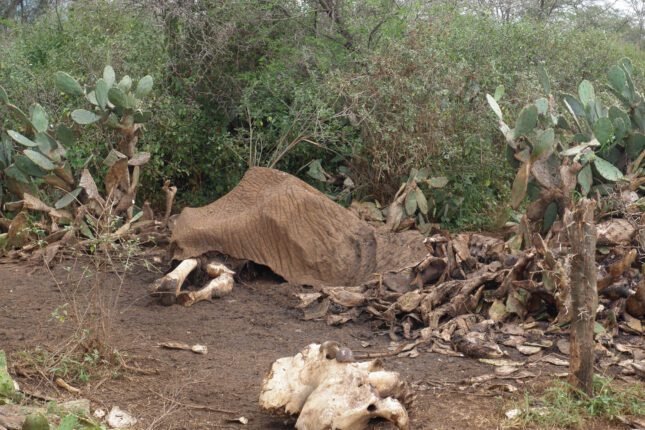-
Addressing Human-Wildlife Conflict in Ethiopia’s Protected Lands
November 19, 2024 By Neeraja Kulkarni
We are undoubtedly at the 11th hour for biodiversity. The World Wildlife Foundation recently reported that Earth saw a 70% drop in species populations over the last fifty years.
As global leaders convened at COP16 in Cali, Colombia in late October and early November, many of the most pressing threats to biodiversity and pathways to improving governance effectiveness were on the agenda. This year’s conference theme—“Peace with Nature”—offered an impetus for a deeper dialogue on the conflict-biodiversity nexus, which included the work of “Peace@CBD”: a community of NGOs, institutions, and individuals that promotes relationships between nature, peace, and conflict.
It is especially in fragile and conflict-struck regions that biodiversity and wildlife face unique pressures from a growing human presence, which is often driven by internal migration and displacement. In Ethiopia, these circumstances have slashed the elephant population from 10,000 in the 1970s to 2,500 to 3,000 elephants in recent years. Places such as Ethiopia’s Babile Elephant Sanctuary offer an opportunity to examine these overlapping crises which impede conservation efforts up close.
A Dismaying Nexus: Humans-Wildlife-Conflict
The Babile Elephant Sanctuary is home to around 250 endangered African elephants, or roughly 27% of Ethiopia’s elephants. Established in the 1970s, Babile occupies a corner of Eastern Ethiopia located near the city of Harar, and has experienced long-term consequences of conflict on its elephants. The Ethiopian-Somali Wars of the 1970s too led to a stark reduction in the elephant population in the sanctuary.
Today, human displacement and insecurity contribute to heightened human-elephant conflict in Babile, which has been on the rise as an increasing number of people move into sanctuary grounds. Over the last few years, ethnic unrest coupled with the influx of refugees from Sudan’s ongoing war have exacerbated internal migration and displacement in Ethiopia. Ethnic clashes in 2020 led to small outbursts of violence between Oromo and Somali groups across the East Hararghe region (which includes Babile.) Climate change-induced weather events such as severe droughts also contribute to the displacement of millions in Ethiopia.
During such socio-politically unstable times, members of displaced communities seeking alternatives, and more stable economic opportunities can perceive protected lands such as Babile to be a viable place to relocate.
Satellite imagery shows that between 2006 to 2017, the number of illegal houses in the sanctuary soared from 18,000 to over 50,000, with 32,000 within the elephant (movement) range. An estimated 35,000 to 50,000 people now live inside these protected sanctuary lands, representing a documented increase in illegal settlements inside Babile. This encroachment has been accompanied by agricultural expansion and increased use of forest resources. Firewood is the main energy source, with industries including wild honey production, edible cacti sales, and harvesting fodder for cattle.
Such forest-dependent activities further strain the land and other resources shared between communities and elephants. They also restrict elephant movements. As a result, elephants searching for food and water (especially during summer months or severe droughts) tend to wander towards settlements and end up destroying croplands.
While such adverse consequences reflect low-level human-elephant conflict, they also can lead to heightened forms of violence. In Babile, these conflicts take the form of poaching (enabled by a sustained illegal ivory trade) and even retaliatory killings in which community members harm wildlife in revenge for wildlife encounters that have proven fatal for community members.
Poaching presents a persistent challenge across Ethiopia’s protected areas for authorities who find it increasingly difficult to govern these unsafe regions. And the Bonn Free Foundation, an NGO active in the region, speculated that 44 elephants which made up 25% of the population were killed over a single year from 2012 to 2013, mostly due to community retaliation. The death of eight community members in 2020 owing to encounters with elephants led to the retaliatory killing of 10 elephants a year later.
Multiple Barriers to Biodiversity Governance
Ethiopia’s Wildlife Strategy and Policy focuses on five key areas for wildlife conservation, including protection and human-wildlife conflict (HWC) mitigation, resource management, and building protected areas to community education research and encouraging private sector participation. It also aims to promote ecotourism to benefit local communities, while encouraging wildlife-related product development for tourism purposes.
Yet these policy steps have not translated into implementation outcomes. Conservation governance efforts led by the Ethiopia Wildlife Conservation Authority (EWCA) often encounter funding and resource constraints. Political and cultural dynamics also can limit or complicate enforcement around conservation in specific protected areas. For instance, past arrests of individuals from particular tribes have led to backlash from those living within those communities. Interviews with local authorities highlight that the politically sensitive nature of poaching investigations also creates difficulties.
Local conflicts also spill over into biodiversity governance and the provisioning of land rights. Sporadic ethnic unrest coupled with changing political leadership and priorities” offer persistent delays in the process of land allocation. In the specific case of Babile, guards point out how the sanctuary’s murky boundaries make it harder for them to strategize and implement patrolling efforts to counter encroachment. Experts also have drawn attention to the need for re-demarcation of the sanctuary’s boundaries, as well as the creation of alternative means for community members to earn their livelihoods.
A Path to Coexistence
Identifying triggers or “pressure points” that exacerbate human-elephant conflict on a sanctuary-to-sanctuary basis also can improve conservation efforts. In Babile, these pressure points include: illegal encroachment-led agricultural expansion, community dependence on forest resources, crop-raiding, and human harm by elephants due to restricted movement as well as poaching and retaliatory killings.
Addressing these triggers also might make conservation co-beneficial by fulfilling the socio-economic and basic needs of communities, including access to ways to make a living. Combining normative conservation activities such as afforestation and demarcation with nature-based solutions is one way to do so. Making provision for reliable and affordable energy such as solar and liquefied natural gas to be provided to households is another. Other efforts might include building water conservation bunds, as well as using participatory methods to demarcate lands, and providing funds to communities to cope with elephant-led crop loss.
To further address the governance shortcomings, conservation co-management in Babile might present a potential livelihood-related solution that also would prove economically beneficial to communities too. This might include strengthening ecotourism and creating patrolling opportunities for forest dwellers and former poachers to counter elephant killings. Such approaches have worked in India, where tiger conservation and ecotourism have provided economic benefits to local communities that improve residents’ perception of—and role in—conservation.
COP16 was dubbed as the “People’s COP” because it sought to underscore the importance of incorporating communities and their traditional practices to increase the efficacy of conservation efforts. The communities near Babile have successfully addressed such conflicts in the past, including a ‘Hyena Feeding Ritual’ which offers a foundation for tailoring conservation solutions by centering on community needs to address today’s new and growing human-wildlife conflict threats.
Note: Field work for this research was supported by the Tufts Elephant Conservation Alliance Grant.
Sources: African Wildlife Foundation; Bonn Free Foundation; Cambridge University; Convention on Biological Diversity; Convention on Migratory Species; Council of Foreign Relations; Environmental Protection Initiative; Ethio Negari; Ethiopia Wildlife Conservation Authority; FAO; The Guardian; Harari Communication; Mongabay; Nature.org; New York Times; Oxfam; Oxford University; Research Square; Science Direct; UN SMART Conservation Tools; UNEP; UNESCO; UNHCR; We Forum; Wild Net; World Wildlife Fund (WWF)
Photo credit: Elephant remains in the Babile Elephant Sanctuary, Ethiopia, courtesy of Neeraja Kulkarni.
 A Publication of the Stimson Center.
A Publication of the Stimson Center.








